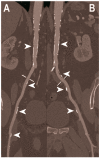Photon-Counting Computed Tomography (PCCT): Technical Background and Cardio-Vascular Applications
- PMID: 36832139
- PMCID: PMC9955798
- DOI: 10.3390/diagnostics13040645
Photon-Counting Computed Tomography (PCCT): Technical Background and Cardio-Vascular Applications
Abstract
Photon-counting computed tomography (PCCT) is a new advanced imaging technique that is going to transform the standard clinical use of computed tomography (CT) imaging. Photon-counting detectors resolve the number of photons and the incident X-ray energy spectrum into multiple energy bins. Compared with conventional CT technology, PCCT offers the advantages of improved spatial and contrast resolution, reduction of image noise and artifacts, reduced radiation exposure, and multi-energy/multi-parametric imaging based on the atomic properties of tissues, with the consequent possibility to use different contrast agents and improve quantitative imaging. This narrative review first briefly describes the technical principles and the benefits of photon-counting CT and then provides a synthetic outline of the current literature on its use for vascular imaging.
Keywords: CT angiography; cardiac CT; photon-counting CT; photon-counting detectors.
Conflict of interest statement
The authors declare no conflict of interest.
Figures







References
-
- Aziz M., Yadav K. Pathogenesis of atherosclerosis a review. Med. Clin. Rev. 2016;2:1–6.
-
- Virani S.S., Alonso A., Aparicio H.J., Benjamin E.J., Bittencourt M.S., Callaway C.W., Carson A.P., Chamberlain A.M., Cheng S., Delling F.N., et al. Heart Disease and Stroke Statistics-2021 Update: A Report From the American Heart Association. Circulation. 2021;143:e254–e743. doi: 10.1161/CIR.0000000000000950. - DOI - PubMed
-
- Andreini D., Martuscelli E., Guaricci A.I., Carrabba N., Magnoni M., Tedeschi C., Pelliccia A., Pontone G. Clinical recommendations on Cardiac-CT in 2015: A position paper of the Working Group on Cardiac-CT and Nuclear Cardiology of the Italian Society of Cardiology. J. Cardiovasc. Med. 2016;17:73–84. doi: 10.2459/JCM.0000000000000318. - DOI - PubMed
Publication types
LinkOut - more resources
Full Text Sources

